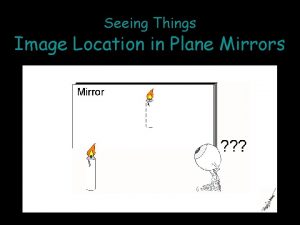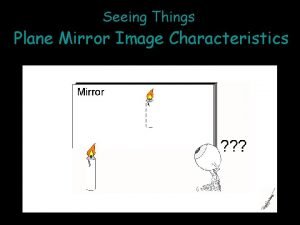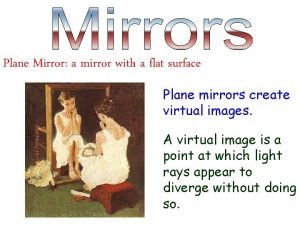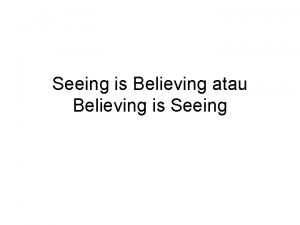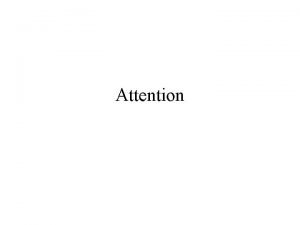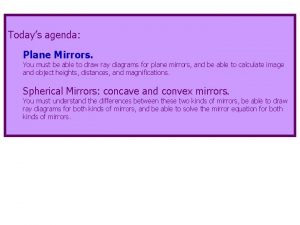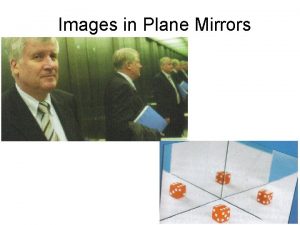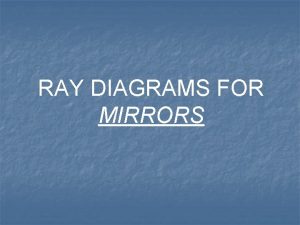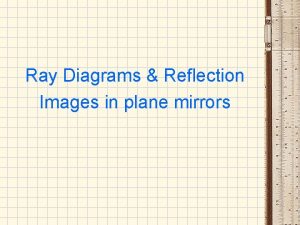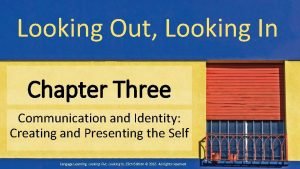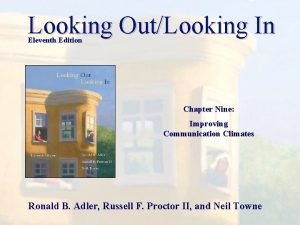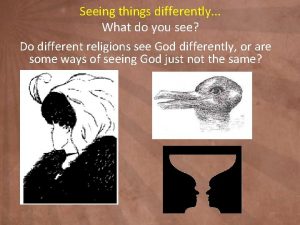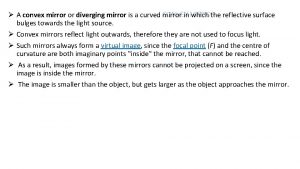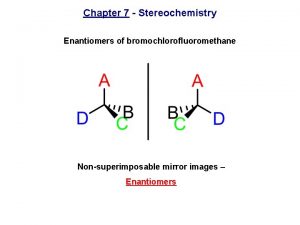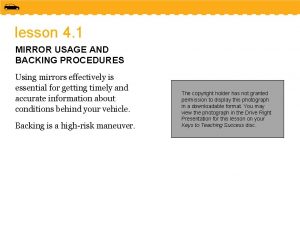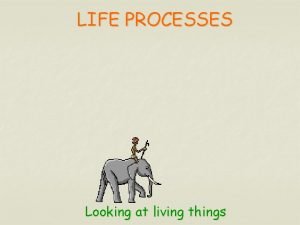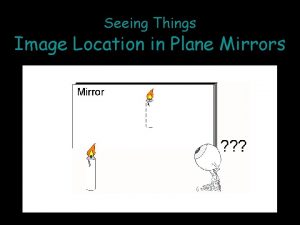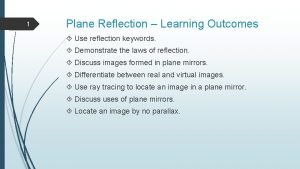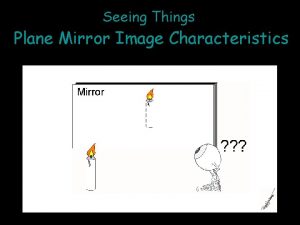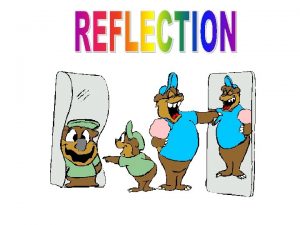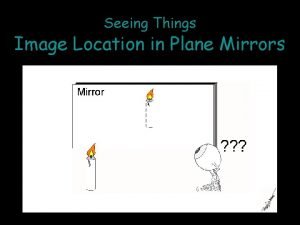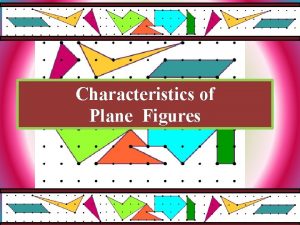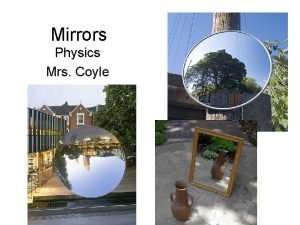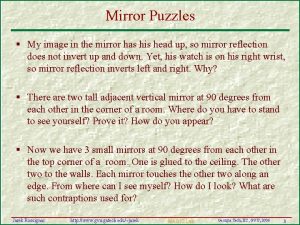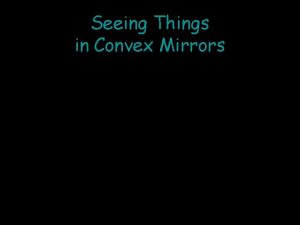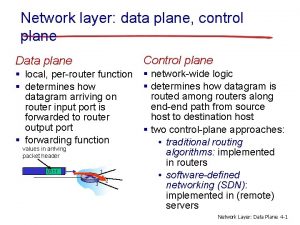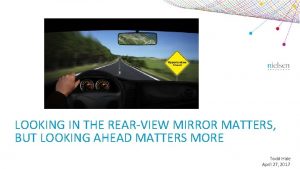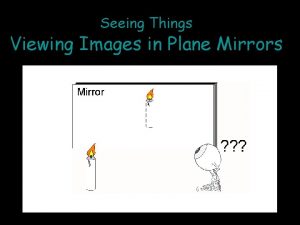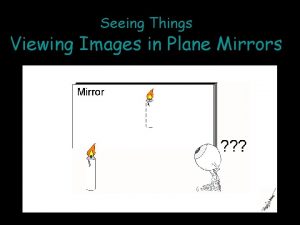Seeing Things Plane Mirror Image Characteristics Looking from




















- Slides: 20

Seeing Things Plane Mirror Image Characteristics

Looking from the Side The distance of points on the object to the mirror is the same as that of corresponding points on the image to the mirror. The object and image appear to be flipped or folded about the mirror.

AMBULANCE OBJECT IMAGE In a plane mirror, RIGHT is changed to LEFT by lateral inversion.

Finally, the image in a plane mirror is called VIRTUAL. We usually see things because rays of light go from what we are looking at straight into our eyes. This applies to real objects as well.

Images. When light rays enter the Eye-Brain, it cannot tell where they actually come from.

Images When light rays enter the Eye-Brain, it cannot tell where they actually come from. The image only appears to be behind the mirror because of the way light reflects off the mirror.

A plain mirror can be treated like a window. The image is seen through this “window”.

Of course, mirrors are not windows. Mirrors are opaque. The only light rays that exist are those that reflect off the mirror. This is why images in plane mirrors are called VIRTUAL.

Review 1) Images in plane mirrors have the following characteristics: • They are the same size as the object. • They are Inverted Front to Back which makes them appear to be left/right or top/bottom inverted. • They are located an equal distance from the mirror as the object is and the line connecting the object and image intersects the mirror at 90 °. • They are virtual.

Review in Table Form SILT - Image Characteristics Review Table Size Same Inversion Location Type Front to Back Equal to Object Distance, 90º Behind Mirror Virtual

REMEMBER SILT (OR SALT) Inversion/Attitude

REMEMBER SILT (OR SALT) � We use 4 main characteristics to describe an image. Size of an image compared to the object (Ex. Same Size, Smaller, Larger)

REMEMBER SILT (OR SALT) Inversion (Attitude) of Image Inversion/Attitude – which way the image is oriented compared to the object: Upright or Inverted (Upside down)

REMEMBER SILT (OR SALT) Location of Image -in front/behind a mirror or lens -distance from mirror or lens compared to object distance

REMEMBER SILT (OR SALT) Type of Image (Real or Virtual) – Real being an image formed when light is actually arriving at the image location (Think of movie projectors). -Virtual being something that looks beyond the mirror (Think of when you see your reflection).

3) Can all Eye-Brain observers see all images? ? a) Show where the images are located.

3) Show where the images are located. Both candles can form an image. The mirror must be extended to find the location of image #2.

4) i. Which Eye-Brain can see the image of candle #1? C) D) & E) can see image #1. The mirror acts like a window. A straight line must exist between the Eye-Brain and image through the mirror.

4) ii. Which Eye-Brain can see the image of candle #2? A) B) C) & D) can see image #2. The mirror acts like a window. A straight line must exist between the Eye-Brain and image through the mirror.

5) What determines whether an Eye-Brain observer can see an image or not? Mirrors act like windows. A straight line through the mirror must exist between the Eye-Brain and image.
 Seeing things in the mirror
Seeing things in the mirror Plane mirror salt
Plane mirror salt A mirror with a flat surface
A mirror with a flat surface Seeing is believing atau believing is seeing
Seeing is believing atau believing is seeing Looking without seeing
Looking without seeing Formation of image of an extended object by a plane mirror
Formation of image of an extended object by a plane mirror Attitude of image in plane mirror
Attitude of image in plane mirror Concave mirror ray diagram
Concave mirror ray diagram Data plane control plane and management plane
Data plane control plane and management plane Plane mirror ray diagram
Plane mirror ray diagram Identity management looking out looking in
Identity management looking out looking in Looking out looking in chapter 9
Looking out looking in chapter 9 Magnipros see things differently
Magnipros see things differently Convex mirror is a diverging mirror
Convex mirror is a diverging mirror Nonsuperimposable
Nonsuperimposable Mirror mirror commonwealth fund
Mirror mirror commonwealth fund Mehran convex mirror
Mehran convex mirror Looking at living things
Looking at living things The seven life processes
The seven life processes Location of plane mirror
Location of plane mirror Plane mirror used in
Plane mirror used in
